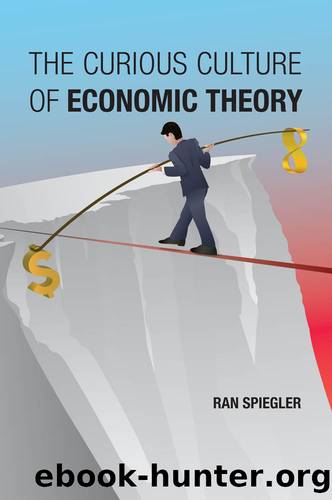The Curious Culture of Economic Theory by Ran Spiegler

Author:Ran Spiegler
Language: eng
Format: epub, pdf
Tags: Economic theory; modern economic thought; game theory; rhetoric of economics; style of economics; culture of economics; behavioral economics
Publisher: MIT Press
The Power of Rational X
The list of examples in this chapter is not exhaustive. I have deliberately focused on some of the most famous examples in the rational X tradition. One prominent example I left out is Bayesian persuasion (Kamenica and Gentzkow 2011), which we already encountered in chapter 3. This model (which is conceptually and technically related to rational inattention) reduces the phenomenon of persuasion to simple Bayesian updating.
Most of economic theory can be viewed as one big ârational explanationâ campaign, trying to conquer more and more areas of human behavior and bring them under the wings of the maximizing paradigm. What I referred to as ârational Xâ are simply the most daring instances of this program. They take types of behavior that people usually assign to the irrationality category and find a way to reconcile them with maximizing behavior of some sort. Yet, as I concluded from the examples, the reconciliation is partial: it leaves important aspects of the phenomenon out of the theoryâs reach, and it also has to compromise the rationality of the behavior it attributes to the decision-maker. The blanket of utility maximization is not as wide as we imagine it to be.
The âimperialismâ of the rational X program is an important reason for its success. Consider the behavioral and social phenomena we have covered in this chapter: ethnic discrimination, wishful thinking, addiction, attention deficit. These are such important and fascinating objects of study. If we look at wishful thinking alone, it seems relevant to voter behavior, provision of health information, media consumption, managerial behavior, and other social and economic arenas. The rational X approach gives us a sense that weâve got these phenomena âfigured out,â and that weâre carrying the great tradition of economics forward rather than undermining it. It lets us play with models that deviate from the norm far enough to make the problem novel and nontrivial, but not too far to deter most theorists from joining the endeavor.
Interestingly, the models I have discussed here were originally proposed by authors who are not card-carrying or full-time microeconomic theorists. Were these economists more comfortable juggling the elements of maximizing models without feeling inhibited by the traditional revealed-preference methodology, which would have exposed the tensions between these models and normatively rational choice behavior?
My description of several highly successful examples of the rational X genre may create the impression that there is a recipe for writing a successful rational X paper. First, identify a problematic or pathological type of individual or group behaviorâideally, one that has been studied by another academic discipline. Next, formulate a maximizing model to describe the phenomenon. Make the utility function mathematically nontrivial yet tractable. If the behavior that comes out of your model isnât exactly rational, be ambiguous about whether you intend this to be a proper rationalization of the phenomenon. If the model is silent over a key aspect of the phenomenon in question, be silent, too.
This impression would be wrong: sorry, there is no surefire recipe. Observe the
Download
The Curious Culture of Economic Theory by Ran Spiegler.pdf
This site does not store any files on its server. We only index and link to content provided by other sites. Please contact the content providers to delete copyright contents if any and email us, we'll remove relevant links or contents immediately.
International Integration of the Brazilian Economy by Elias C. Grivoyannis(57388)
The Radium Girls by Kate Moore(10915)
Turbulence by E. J. Noyes(7057)
Nudge - Improving Decisions about Health, Wealth, and Happiness by Thaler Sunstein(6642)
The Black Swan by Nassim Nicholas Taleb(6203)
Pioneering Portfolio Management by David F. Swensen(5616)
Rich Dad Poor Dad by Robert T. Kiyosaki(5162)
Zero to One by Peter Thiel(4834)
Man-made Catastrophes and Risk Information Concealment by Dmitry Chernov & Didier Sornette(4748)
Secrecy World by Jake Bernstein(3788)
Millionaire: The Philanderer, Gambler, and Duelist Who Invented Modern Finance by Janet Gleeson(3576)
Skin in the Game by Nassim Nicholas Taleb(3477)
The Age of Surveillance Capitalism by Shoshana Zuboff(3432)
The Money Culture by Michael Lewis(3291)
Skin in the Game: Hidden Asymmetries in Daily Life by Nassim Nicholas Taleb(3272)
Bullshit Jobs by David Graeber(3190)
The Dhandho Investor by Mohnish Pabrai(3176)
The Wisdom of Finance by Mihir Desai(3086)
Blockchain Basics by Daniel Drescher(2896)
